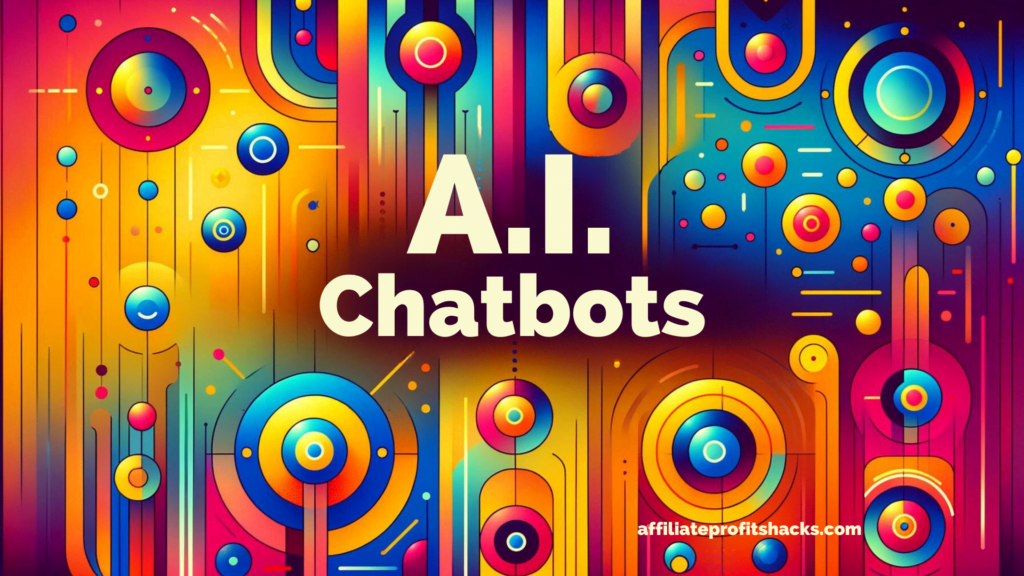AI Chatbots in Customer Service: A Revolution in User Experience
Welcome to my article about how AI Chatbots are revolutionizing the customer service experience.
AI chatbots are changing how we think about customer service. They are computer programs that talk like humans. They can help users any time of the day, answering questions and offering help. Unlike traditional customer service, AI chatbots can talk to many people at once. They are always learning to get better at what they do. This change is big. It’s making customer service faster and more personal.
Best Recommended and Proven Way to Make Money Online – Click HERE for Instant ACCESS >>

Moving to Tech-Based Service
AI chatbots use new technology to work. They use things like natural language processing (NLP) and machine learning. This lets them understand and use human language in a smart way. Now, customer service can be faster, available all the time, and more personal. This matches what customers today expect.
Benefits for All
Chatbots are great for businesses and customers. They handle tasks without needing to take breaks. This means they can offer help at any time, making customers happy. They also save businesses money by doing routine tasks. This lets human agents focus on more complex issues. Plus, chatbots can make each interaction personal by remembering past talks.
What’s Next
The future looks bright for AI chatbots. They will get smarter and better at understanding complex tasks. But, there are challenges too. We need to make sure they keep information private and fit well into existing customer service systems. This article will look at how AI chatbots work, their benefits, and what they might do in the future.
The Technological Advancements Behind AI Chatbots
AI chatbots are smart because of two key technologies: natural language processing (NLP) and machine learning. These make chatbots good at talking to people in a way that feels natural and helpful.
Understanding Natural Language Processing (NLP)
NLP is what lets chatbots understand us. It helps them figure out what we mean, not just what we say. This means chatbots can get the gist of our words, catch the mood, and even the hidden meanings. NLP is why chatbots can chat in a way that makes sense and feels right.
Learning from Experience: Machine Learning
Machine learning is about getting smarter over time. Chatbots use this to learn from every chat they have. They get better at answering questions and helping out. This learning makes chatbots more helpful the more they chat with people.
Chatting Gets Better
Thanks to NLP and machine learning, chatbots can have real conversations. They’ve moved past simple, pre-planned talks. Now, they can chat more like a person would. This makes talking to them smoother and more enjoyable.
Looking Ahead
Technology is always moving forward. This means chatbots will keep getting better at understanding and helping us. They’ll learn to handle more complex chats and offer even more personal help. As tech improves, chatbots will become an even bigger part of good customer service.
This tech is why AI chatbots are becoming essential for businesses. They help make customer service faster, smarter, and more personal.
Benefits of AI Chatbots for Businesses and Customers
AI chatbots are not just a smart piece of technology; they bring plenty of advantages to both businesses and the people they serve. Let’s dive into how they make things better for everyone involved.
Always There to Help
Chatbots are ready to help any time, day, or night. Unlike human staff, they don’t need breaks or sleep. This means customers can get help whenever they require it, making services more reliable and satisfying.
Saving Money and Time
For businesses, chatbots are a game changer. They take care of routine questions and tasks, freeing up human employees for more complex issues. This saves on labor costs and makes the whole customer service process more efficient.
Personal Touch
One of the coolest things about chatbots is how they can make each chat feel personal. They remember past interactions and preferences. This means they can offer help that’s tailored to each person’s needs, making the experience better for customers.
Keeping Customers Engaged
Chatbots keep conversations going. They’re programmed to be interactive, which means they can keep customers interested. This is great for businesses because engaged customers are more likely to stick around and use their services.
Wide Range of Uses
Chatbots are versatile. They’re used in many industries, from retail to healthcare. They help with everything from shopping advice to booking appointments. This wide range of uses shows just how valuable chatbots can be for different kinds of businesses.
AI chatbots are transforming customer service. They offer help that’s quick, personal, and available anytime. For businesses, they save money and make operations smoother. For customers, they make getting help easy and satisfying. As technology continues to improve, chatbots will become an even bigger part of our daily lives.
Real-World Applications of AI Chatbots
AI chatbots are more than just a tech trend; they’re making a real difference in how industries operate and serve their customers. Let’s explore some ways these digital helpers are being put to use.
Shopping Made Easy
In retail, chatbots are like personal shopping assistants. They can answer questions about products, help track orders, and even offer recommendations. This makes shopping online easier and more fun for customers.
Banking at Your Fingertips
The banking sector has also embraced chatbots. They help users check balances, transfer money, and find answers to common questions. This means people can manage their finances anytime, without waiting in line or on the phone.
Health Care Support
In health care, chatbots offer a new way to get advice and information. They can schedule appointments, provide reminders, and even give basic health tips. This support makes health care more accessible for everyone.
Learning with Chatbots
Education is another area where chatbots are making an impact. They can tutor students, answer questions, and help with homework. This interactive learning helps students stay engaged and get the support they need.
Customer Service Across Industries
Across all industries, chatbots are improving customer service. They handle common questions and issues, freeing up human staff for more complex tasks. This leads to faster, more efficient service for everyone.
Best Recommended and Proven Way to Make Money Online – Click HERE for Instant ACCESS >>
AI chatbots are showing up in all kinds of places, making life easier and businesses more efficient. They’re changing the way we shop, bank, take care of our health, and learn. As technology continues to advance, we’ll see chatbots doing even more to help us in our daily lives.
The Future of AI Chatbots in Customer Service
As we look ahead, AI chatbots are set to play an even bigger role in customer service. The future is bright, with new technologies making chatbots smarter and more helpful. Let’s see what’s on the horizon for these digital assistants.
Smarter Conversations
Thanks to advances in AI, future chatbots will understand us better than ever. They’ll get better at picking up on what we mean, not just what we say. This means they’ll be able to handle more complex questions and offer more helpful responses.
More Personalization
As chatbots learn from every interaction, they’ll become experts at personalizing conversations. They’ll remember your preferences and history, making each chat more relevant to you. This level of personal service will make customer experiences even better.
Working Together with Humans
Chatbots won’t replace human customer service agents; they’ll work alongside them. By taking care of routine tasks, chatbots will free up humans to handle more complex issues. This teamwork will make customer service faster and more effective.
Expanding Roles
Chatbots will start showing up in more parts of our lives. Beyond customer service, they’ll help with things like health care, education, and even entertainment. As chatbots become more versatile, they’ll become a bigger part of everyday life.
Building Trust
As chatbots become more common, building trust will be key. Companies will need to make sure chatbots are respectful of privacy and transparent about how they use data. Trust will be crucial for chatbots to be accepted and used by more people.
The future of AI chatbots is full of possibilities. They’re going to make customer service better and touch more parts of our lives. As technology evolves, chatbots will become even more valuable tools for businesses and customers alike.
Ethical Considerations and Best Practices in AI Chatbot Implementation
As AI chatbots become increasingly integral to customer service, it’s crucial to navigate the ethical implications and establish best practices for their use. This ensures that while businesses leverage chatbot technology to enhance efficiency and customer satisfaction, they also maintain a commitment to ethical standards and customer trust.
Prioritizing Data Privacy and Security
The foundation of effective and ethical AI chatbot use is robust data privacy and security measures. Chatbots often handle sensitive customer information, making it imperative for businesses to implement stringent data protection protocols. This involves encrypting data transmissions, securing data storage, and ensuring compliance with global data protection regulations such as GDPR. Prioritizing customer privacy builds trust and ensures a secure environment for digital interactions.
Maintaining Transparency with Users
Transparency is key when deploying AI chatbots. Customers should be informed when they are interacting with a chatbot and assured of the bot’s role in handling their queries. Furthermore, businesses should disclose how data collected by chatbots will be used, reinforcing the commitment to privacy and building trust with users.
Ensuring Accuracy and Reliability
For chatbots to be effective, their responses must be accurate and reliable. Misinformation can lead to frustration and erode trust in digital services. Regularly updating the AI models with correct information and testing chatbot responses for various scenarios are best practices that enhance reliability.
Blending AI with the Human Touch
While AI chatbots offer remarkable efficiency, the human touch remains invaluable, especially for complex or sensitive issues. Implementing a seamless handoff process from chatbots to human agents ensures that customers receive the appropriate level of care and empathy when needed. This blend of technology and human service highlights a commitment to comprehensive customer support.
Continuous Improvement and Feedback Loops
Adopting a mindset of continuous improvement is essential for the successful integration of AI chatbots. This involves analyzing chatbot interactions to identify areas for enhancement, incorporating customer feedback to refine chatbot responses, and staying updated with the latest AI advancements. Establishing feedback loops with users can also provide direct insights into the effectiveness and areas for improvement of chatbot services.
Implementing AI chatbots in customer service with these ethical considerations and best practices ensures that businesses not only enhance their operational efficiency and customer experience but also uphold high standards of responsibility and trustworthiness. As we navigate the future of digital customer service, maintaining a balanced approach that values both technological innovation and ethical standards will be key to fostering positive and trust-based relationships with customers.
Integration Challenges and Strategies for AI Chatbots
As AI chatbots become a staple in customer service, integrating them into existing systems presents unique challenges. Successfully overcoming these obstacles requires a strategic approach, ensuring chatbots complement rather than complicate the customer service ecosystem.
Understanding Integration Challenges
Integrating AI chatbots involves more than just technical deployment. It requires aligning chatbot functions with existing customer service channels, databases, and CRM systems. Challenges include ensuring data consistency across platforms, maintaining a unified customer service experience, and training staff to work alongside AI tools effectively.
Aligning Chatbots with Customer Service Goals
A critical first step in overcoming integration challenges is to clearly define the role of chatbots within the broader customer service strategy. This involves identifying specific tasks chatbots will handle, such as answering FAQs, gathering customer information, or providing 24/7 support. Aligning chatbot capabilities with key service goals ensures they meet actual needs and enhance the overall customer experience.
Seamless Data Integration
For chatbots to provide personalized and efficient service, they must have access to relevant customer data. Integrating chatbots with existing databases and CRM systems is essential for this. Using APIs (Application Programming Interfaces) and ensuring compliance with data protection standards are crucial steps in facilitating smooth data integration and access.
Best Recommended and Proven Way to Make Money Online – Click HERE for Instant ACCESS >>
Training and Support for Human Agents
Integrating AI chatbots affects not just technological infrastructure, but also the human aspect of customer service. Providing training for customer service agents on how to work effectively with chatbots is essential. This includes understanding when and how to transfer interactions from chatbots to humans, and how to use insights gathered by chatbots to enhance customer engagement.
Continuous Evaluation and Adaptation
Integration is not a one-time effort but an ongoing process. Regularly evaluating the performance of AI chatbots, collecting feedback from users and service agents, and making necessary adjustments is vital. This iterative process ensures that chatbots remain an effective and integral part of the customer service framework.
Developing a Phased Implementation Plan
A phased approach to chatbot integration can help manage the complexity and minimize disruption. Starting with pilot projects or specific customer service areas allows businesses to test and refine chatbot interactions before a full-scale rollout. This strategy enables learning and adjustments in a controlled environment, reducing the risk of negative customer experiences.
Integrating AI chatbots into existing customer service frameworks requires careful planning, coordination, and a commitment to ongoing improvement. By addressing the technical and human aspects of integration, businesses can leverage the full potential of chatbots to enhance service delivery and customer satisfaction.
Conclusion
AI chatbots are transforming the way businesses interact with their customers. These digital helpers are powered by advancements in natural language processing and machine learning, making them capable of understanding and engaging in meaningful conversations. They’re available 24/7, providing immediate assistance and making customer service more efficient and personalized.
Chatbots have found their place across various industries, from retail to healthcare, offering support that ranges from answering FAQs to providing personalized shopping advice. They’re making services more accessible and enhancing the overall customer experience by ensuring that help is always just a message away.
Looking forward, AI chatbots are expected to become even smarter and more integrated into our daily lives. They will continue to improve in understanding complex queries, personalizing interactions based on individual user data, and working alongside human agents to provide a seamless service experience. With these advancements, chatbots are set to redefine customer service, making it more responsive, efficient, and tailored to individual needs.
The evolution of AI chatbots represents a significant shift in the landscape of customer service. By automating routine interactions and personalizing customer engagement, chatbots are enabling businesses to meet the high expectations of today’s digital-savvy consumers. As we look to the future, the role of AI chatbots in customer service is only set to grow, promising a new era of digital assistance that is more intuitive, helpful, and accessible than ever before.
This journey into the world of AI chatbots has shown us the potential of technology to enhance the way businesses connect with their customers. As we continue to explore and embrace these digital advancements, the possibilities for innovation and improvement in customer service seem limitless.
Thank you for reading my article “AI Chatbots in Customer Service: A Revolution in User Experience”. I hope you found it informative and helpful!
Best Recommended and Proven Way to Make Money Online – Click HERE for Instant ACCESS >>
For more insights into network marketing, take a look at this article: The Rise of the Machines: How AI is Reshaping Digital Marketing







